|
|
METAHISTORY
S i t e G u i d e
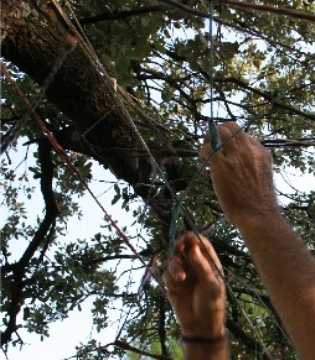
Writings by John Lash and Lydia Dzumardjin
The purpose of this guide is twofold: provide one-click access to any text on the site, and showcase the topics and themes treated in those texts. To assist navigation through this material, the guide follows the buttons on the menu panel. This is a teachng site so each button can be regarded as a classroom, or a course being offered there. This guide shows where you go by entering each classroom and previews the topics to be explored, the subject matter on offer, etc.
Please note indications of unfinished work.
PLANETARY TANTRA has its own site guide: Tantra Tour. The link to Planetary Tantra is found at the top of the home page: click on the banner beneath the menu panel. This link is consistent on all pages with the metahistory heading. Pages in PT have a different heading with the link back to metahistory through the tree and well logo in the lefthand column.
Click for SPOKEN TOUR of metahistory.org (part 1).
* * * * * * * *
See the French Site Liberterre for translations of many articles from metahistory.org, plus chapters from Not in His Image |
HOME PAGE
defines metahistory.org as a teaching site and states its dual purpose: to critique beliefs and invite a future myth to guide humanity.
The "future myth"proposed in metahistory is not the author's personal invention, and not a channeled scenario. It is a recovery and extrapolation of the sacred narrative of the fallen goddess Sophia derived from the Pagan Mysteries of pre-Christian Europe, Egypt, and the Levant. Hence the mission statement links immediately to the story of Gaia-Sophia, a myth in progress.
Throughout the site, a click on the Tree and Well logo in the upper lefthand of the first page of every file returns you to the home page. Or use the menu panel at the end of each document.
How Metahistory Works (starting beneath the cartouche that signals recently posted material) is the opening orientation essay with emphasis on the Socratic angle of the site. Both these essays belong to the category (/folder) of
GUIDELINES
Essential orientation to the concept of metahistory, its assumptions, themes, and applications.
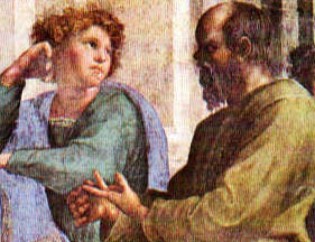
Socrates in dialogue. Raphael, The School of Athens
How Metahistory Works sets out the Socratic orientation of the site and examines the problems posed by the inveterate need to believe in what cannot be proven or tested.
The
death of Socrates in 399 BCE was said to have been a voluntary act,
self-applied euthanasia. The old sage had several offers
to leave Athens, but chose to stay and face conviction on two bogus charges: "corrupting the youth" and asebia, impiety—refusal to honor the accepted dieties of high Athenian culture. On that count, you could say he died
for what he did not believe. i.e., the spiritual authorities.
This was his greatest
heresy, and it is also his finest legacy.
Hemlock smoothie, anyone?
Socrates in the Last Days offers an idiosyncratic
portrait of the mascot of metahistory and takes a wild shot at
explaining his unique position in the Western intellectual tradition.
On the Hidden Deception in Believing is a mock-up of a dialogue with Socrates who opens with this challenging suggestion: What if we do not adopt beliefs because
we find truth in them, but only, once they are adopted, come
to regard them as true? He contrasts the truth value of a belief to its expedient value, the reason why it was adopted. This
dialogue
exemplifies the technique of dereasoning beliefs, the third basic
tool of metacritique. The other two are: assessing belief by the
behavior it produces, and defusing belief by analysis of the rationale
constructed
around it.
|
Tree and Well explains the logo of metahistory.org, a composite of ancient images of a magical tree and a sacred spring or well.
The Right to Believe is a brief, one-page text addressing the risk of believing in blind faith, that cannot be verified, balanced against the necessity to believe in what may be possible.
The Four Concerns considers how all human concerns reduce to four primary issues corresponding to the four relations that
pertain between God, Nature, and Humanity. Compare with A Concise Inventory of Beliefs under gnostique/Metacritique.
In the Knowledge that Frees explains the status of metahistory.org as a teaching site.
The Themes: The Arch of Metahistory with its five themes presents a suggested format for thematic organization of the material on the site.
Sacred Nature: All we know and are is rooted in the earth.
Opposition: Everything develops by polarities, with or without conflict.
Origins: We postulate beginnings by the act of recording them.
Moral Design: Is there justice and equilibrium in human reality?
Technology: In ancient and modern times alike, our tool-making skills set the course of our experience.
Background to Metahistory is long essay on the antecedents of metahistory, going back to founding of Rome in 747 BCE, an event in which mythical and history converge, and coming forward to the modern definition of metahistory proposed by the academic Hayden White.
Myth in Metahistory is on long essay on the nature of myth, the eight categories of mythic narrative, and problems concerning the use of myth in its application to actual experience.
The Uses of the Erotic by Audre Lorde is an exception on the site, a rare guest writer. Metahistory.org does not feature the writings of any other authors except this one. Audre Lorde was a black lesbian feminist active in the 1970s. Her view of the erotic resonates closely to the spirit and tone of metahistory.org, and especially the goddess material. See, for instance, in the Eros section of Gaia-Sophia: Coco de Mer.
More orientation-type essays with emphasis on the Gnostic angles of metahistory can be found in Gnostique/Telestics.
********
READING
Here is more orientation material, including 36 suggested books for research and reference, and a few book reviews. Special emphasis on the Gnostic literature: NHL, Nag Hammadi Library.
Basic Reading in Metahistory, introduction to suggested reading.
14 Essential Books with reviews and comments on their relevance to the metahistorical perspective.
Suggested Books for the Themes (15), each with a brief review.
The Seven Classics, a long essay with reviews of unmissable writings on prehistory, goddess religion, mythic astronomy, and more.
Selective Book List offers one-page, one-click access to all 36 recommended books.
Bibliography, a partial list of books from my library which in its entirety is now on offer as an endowment.
Books by John Lash, in and out of print.
/ REVIEWS is the portal to this folder, listing the books reviewed:
The Candle of Vision by AE
Mary of Magdala by Karen King
The Message of Judas, various books on the Gospel of Judas
A Language Older Than Words by Derrick Jensen
The Biology of Transcendence by J. C. Pearce
The Mystery of the White Lions by Linda Tucker
Other reviews specific to Gnosticism in gnostique/tar baby jesus.

/NHL is the folder for my extensive commentaries on the Coptic writings discovered at Nag Hammadi in Egypt early in December 1945, the week, month, and year I was born. Introduction to the Nag Hammadi Reading Plan explains my selection and reasons for the three-part breakdown.
Access to the Reading Plan lists all the texts in my three-part breakdown for reading these diverse and chaotic materials. The Plan does not cover all fifty-two tractates from Nag Hammadi, or any other non-NHL Coptic writings such as the Pistis Sophia. I selected only thirty-two texts out of the total fifty-two from Nag Hammadi.
THE READING PLAN: READING/NHL/
The Prayer of the Apostle Paul,
NHC I, 1.
Level One: The Mysteries and the Master
Text 1: Allogenes, XI, 3
Text 2: The Apocalypse of Peter,
IV, 1
Text 3: The Dialogue of the Savior,
III, 5
Text 4: The Gospel of Thomas,
II, 2
Text 5: The Second Treatise of
the Great Seth, VII, 2
Text 6: The Sentences of Sextus,
XII, 1
Text 7: The Teachings of Silvanus,
VII, 4
Text 8: Thunder, Perfect Mind,
VI, 2
Level Two: Ritual and Revelation
Text 9: The First Apocalypse of
James, V, 3
Text 10: The Apocryphon of James,
I, 2
Text 11: The Book of Thomas the
Contender, II, 7
Text 12: The Gospel of Philip, II, 3
Text 13: The Reality of the Archons, II, 4
Text 14: On the Origin of the World, II, 5; XIII, 2
Text 15: The Testimony of Truth, IX, 3
Text 16: The Tripartite Tractate, I, 5
Text 17: A Valentinian Exposition, XI, 2
Level Three: The Sense of Cosmic Order
Text 18: The Apocalypse of Adam, V, 5
Text 19: The Second Apocalypse of James, V, 4
Text 20: The Apocryphon of John, II, 1; III, 1; IV, 1 (three versions)
Text 21: The Concept of Our Great Power, VI, 4
Text 22: The Discourse on the Eighth and the Ninth, VI, 6
Text 23: Eugnostos the Blessed, III, 3; V, 1 (two versions)
Text 24: The Sophia of Jesus Christ, III, 4
Text 25: The Exegesis of the Soul, II, 6
Text 26: The Gospel of the Egyptians, III, 2; IV, 2 (two versions)
Text 27: The Gospel of Truth, XII, 2
Text 28: Marsanes, X
Text 29: The Paraphrase of Shem, VII, 1
Text 30: The Three Steles of Seth, VII, 5
Text 31: Trimorphic Protennoia, XIII, 1
Text 32: Zostrianos, VIII, 1
NOTE: The NHL Reading Plan is an unfinished book.
To my knowledge, there is so far (December 2009) no alternative guide comparable to this one that treats the NHL material from the Pagan Gnostic viewpoint, rather than from the angle of Judeo-Christian scholarship. Both viewpoints are biassed, of course. My viewpoint gives fair represention to the non- and anti-Judeo-Christian elements of the Coptic writings, and takes a huge bite into the Archon material which scholars avoid like the plague due to their fear of dabbling in psychic and supernatural matters. Furthermore, my commentaries come from someone who admits having mystical experiences comparable to those described in the texts, rather than from armchair scholars who lack the benefit of such experiences, or would be loth to admit having them if they ever did.
I regret being unable to complete these in-depth commentaries and offer them in a book. But there is only so much time in life for life. JLL |
Gnostic Alphabetic NHLE is an alphabetic list of the texts in the standard English translation of the Coptic books from Nag Hammadi: The Nag Hammadi Library in English, edited by James Roberston. As if this material were not chaotic enough in the first place, the table of contents in that book makes it difficult to locate any particular text. Over the years, I have found that I end up having to riffle the entire table contents each time I want to return to a specific document. I provide this list merely for reader convenience. Print it out and keep it inside your copy of the NHLE.
Gnostic Source Materials (note on sources in the site bibliography)
Gnostic Studies
(from Not in His Image) Reading and Research
LEXICON
This large section of the website is not displayed by any button on the menu panel, but may be accessed at the Introduction. Definitions in the Lexicon are linked occasionally throughout the site when specific terms such as behavior call for clarification. I have taken this feature out of circulation because it is a massive project I was unable to finish or edit properly, so it contains some gaps and errors. However, it is still there to be explored if you are inclined. The index page lists all the entries and most of the links seem to work.
If this is only one entry you read in the Lexicon, make it this: Zaddikim
ALTERNATIVE GRAIL
nine chapters of a thirteen-chapter book on the quest for the Holy Grail, considered by Joseph Campbell to be the most important secular myth of the Western world. The book traces an untold story: the diaspora of the Pagan Mysteries after 400 AD. It describes how refugees from those ancient schools of visionary science sought santuary in the far westlands of Europe, in Brittany, Wales, Ireland. This historical account of the survival of the Mysteries is exclusive to metahistory.org. To my knowledge, such an account cannot be found anywhere else on the internet or in any book.
An Alternative History of the Grail
1. Grail Magic Versus the Paternal
Lie
The Grail Quest entails a challenge to expose the paternal lie about the message of the off-planet father god, and counteract that lie by direct engagement with the power of the Goddess, the living earth. The mythemes of hero and goddess and hero (true man) versus patriarch underpin the Grail narrative, as explained in my book The Hero - Manhood and Power
Parzival by Wolfram von Eschenbach: A Synopsis
Ahandy recounting of the complex medieval story.
2. The Destiny of the Swan Knight
3. Three Currents from the Grail
4. The Radiant Wisdom Stone
5. The Most Enigmatic of All Enigmas
It is possible to describe in a concrete and explicit way what the Grail was in experiential terms, an experience rather than a symbol or relic. Doing so, I make an unprecedented claim: attainment of the Grail was a direct encounter with the Organic Light, the "radiant wisdom stone." Whoever chooses to undertake the Quest can verify this claim first-hand. It is not a theory I expect anyone to accept. It is not my pet notion. It is not a matter of speculation any more than is the presence of oxygen in your lungs.
6. Spiritual Warriors of the
Grail
7. Sacred Love, Sacred Light
8. Faith Incarnate
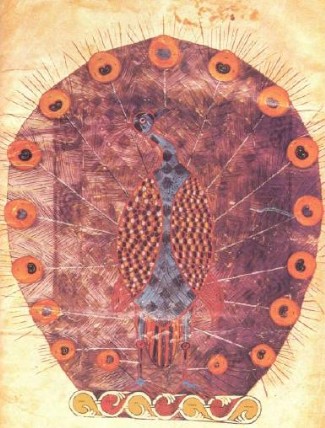
(Alchemical Peacock, image of psychedelic vision
of the Organic Light, the goal of the Great Work.
In the Grail legend, the wounded Fisher King wears
a peacock plume in his hat.)
The mystical quest for the Grail is linked closely with the knights of the Round Table and the troubadours. Because the Arthurian order of knights was founded to protect the refugees from the Pagan Mysteries who preserved direct knowledge of "attainment of the Grail," that is, first-hand encounter with the Organic Light. Arthurian literature was the genre in which that knowledge became encoded. Among the troubadours, romantic love was intertwined with the Grail Quest: the Girl and the Grail were regarded as one. The mystique and ethos of romantic love, defined at "the mythogenetic moment" (Campbell's term) of 1250 AD, defined a highpoint of human spirituality, but that moment was also the gateway into the oppression, deceit, and addiction of our time.
9. The Tale of the Magic Garland
The Gawain Episodes: A Synopsis (forthcoming)
This chapter discloses the lore of entheogenic shamanism encoded in the Grail legend. It affirms that the ancient Mysteries, even in their late survival down to the 13th century, contained extensive knowledge of sacred plants and used such plants for visionary trance to acquire supernatural power and enjoy direct access to the Organic Light.
10. The Bleeding Lance
11,
12, 13 ...incomplete
With chapter 10, this book brings the Grail legend up to the 20th century, showing how the Nazis adapted the legend to their political agenda. The uncompleted chapters would then show how Grail lore survived clandestinely in Russia and from there, starting with Vernadsky, produced what we today call Gaia theory.
NOTE: The Alternative History of the Grail is also an incomplete book, and remains so as of December 2009....
|
PSYCHONAUTICS
Originally conceived in three parts, but only Part 1, covering the years 1935 - 1965, has been completed so far: The Psychonautic Adventure. Right now I can't say if or when I will complete the two remaining parts, generation two 1965 - 1995, and the current generation, 1995 - current. The remainder of this classroom consists of two folders:
/Eadwine
The Discovery of a Lifetime describes how I found in the National Library in Paris a medieval ms. of the 13th Century, the Paris Eadwine Psalter, the only copy in existence, lavishly illustrated with Daliesque images of psychoactive mushrooms.
Entheogenic Revelation: The Paris Eadwine Psalter outlines my proposed book on the Wasson theory of the origin of religion (working title "Paradise Denied'), a project that did not get sold. It relates the Eadwine psalter to the Mysteries, in particular to perception of the molecular structure of DNA in a heightened state induced by psychoactive plants.
Illuminated Heresy presents further commentary with illustrations from the Eadwine psalter, including one image of Christ tempted by an antlered shaman-devil in a mushroom grove.
Mystic Jesus: Hanged Man and Dancer offers yet more jaw-dropping images from the Eadwine psalter, included Christ inverted and an explicit cameo of Jesus dancing with Mary Magdalene. All in all, extraordinary evidence for Gnostic heresy and entheogenic mysticism preserved in this unique medieval text.
Forbidden Fruit: The Psalter of Saint Louis compares images of another psalter containing entheogenic imagery with the Eadwine illustrations.
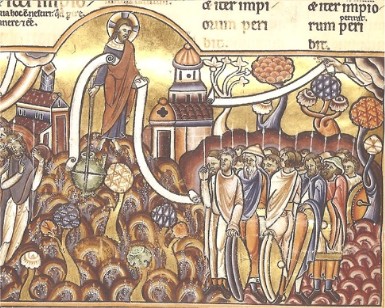
/Wasson
The Entheogenic Theory of Religion sets out my strong objections
to the trendy notion (coming from Benny Shannnon, John Rush, and others)
that patriarchal figures
like Moses and Jesus, iconic proponents of salvationist religion, acquired their message by inspiration from sacred teacher plants.
The Oldest Taboo in the World: Introduction to Wasson Book (incomplete and unpublished). Considers the taboo encoded in the Old Testament myth of the Temptation of Adam and Eve, forbidding the eating of sacred plants that give wisdom or a divine or god-like nature.
The Banker and the Bruja: Chapter One of Wasson Book - describes the meeting between R. Gordon Wasson and the Mazatec shaman Maria Sabina, resulting in the handover of psychoactive plant mysticism by its indigenous practitioners, making it known to the world at large.
LYDIA'S WELL
is a small collection of writings by my long-time friend and loyal tantrika, the only other living author to be featured on his site. Her intimate testimony includes an explanation of the timing and circumstances of our disclosure of the Organic Light, the ultimate secret of the Mysteries.
Lydia's Vow explains the sacred vow to reveal the sworn secret of the Mysteries: instruction by the Light.
Lydia Dancing describes the origin of sarod thread dancing, which Lydia teaches as she wanders about the land.
The Throw of Dice introduces the Kali Dice Oracle, a conversational divination game for the communities of the future.
Recapitulations of her lives, recounted in reverse order:
9: Pia, called "The Raven (La Corvina)," Italian courtesan
8: Alisan de Monfaucon, Celtic bard
7: Lydia of Damascus, telestes
6: Socrates, dialectician
5: Priam, Prince of Troy
4: Timotheos of Naxos, stone mason
3, Nefer-Hat-Shu / Nefer-Nut-Shu, hieratic daughters of Amon
2, Asuramaya, Hindu astrologer
1, Zev the Magian
GNOSTIQUE
The new folder named Gnostique (formerly /VIEWS) contains essays arranged in
five categories: Metacritique, The Archon Files, Tar Baby Jesus, Telestics. and The Gnostic Castaneda. Each of these sections comprises a complete book of research-based interpretative material.
I have coined the term "gnostique" for this collection of writings with a Gnostic spin, contrasted to the actual source texts of Gnosticism and my commentaries (above).
A mystique is an air or attitude of mystery developing around something, or, the specialist or esoteric skill essential to a field or calling. The coined term gnostique refers both to the genuinely mysterious aura of Gnostic teachings and the special expertise of those ancient seers. I argue that gnosis, the practice of cognitive ecstasy, was an ancient version of what we today call the noetic sciences, including parapsychology.
A lecture series in 9 parts (November-December 2012):
Gnostic Sabotage in the Book of Revelation
1 Opposition to the Divine Plan - 23 Nov
2 Animal Powers Revealed - 23 Nov
3 Interlude: Diaspora of the Mysteries - 25 Nov
4 A Pagan Apocalypse - 26 Nov
5 Charagma - Bull's Eye of the Beast - 27 Nov
The Mad Monk's Dream
/Metacritique
The Heruka is a form of the Wrathful Dieties who appear in the afterdeath experience,
according to the Tibetan Books of the Dead. This charming
monster is equipped with razor-sharp steel claws like those
of the demon Freddy in the popular horror film, Friday
the 13th. With these spectacular nine-inch nails, the
Heruka strips away beliefs and false notions of self so that
the deceased is liberated into the ecstatic non-self beholding
of the Bardos.
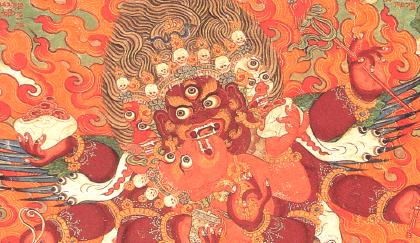
The sensation of yielding to Heruka's claws is as exquisite
as being flayed alive, I suspect, but that's what you get for
identification with beliefs. The effort of metacritique can be
painfully arduous at moments, but it's nothing compared to the
afterdeath stripdown. In these essays I attempt to lay out the methodology for a clear
and consistent critique of belief and belief-systems. Nasty work,
but someone's gotta do it.... I convey my immense gratitude in
advance to any and all readers who dare to take this challenge. However you cut the deck, metacritique of beliefs may be essential to human sanity, individuallly and collectively.
Belief-Change - an essential definition, linked to How Metahistory Works
Defusing Belief set out a technique of metacritique that may be compared to defusing a bomb without triggering the detonation system.
Modes of Believing a list (incomplete) of 38 specific forms of belief with examples. Some examples are also missing.
A Concise Inventory of Beliefs breaks down beliefs into three types following the classification of Pierre Miranda: metaphysical, moral, existential. And provides a useful spot check to detect what you believe.
Phantom Belief defines one of the more problematic forms taken by belief when it becomes severed or dissociated from the experience or source that produced it.
The Placebo Effect presents a contrast between two concepts of healing.
Reflex Belief is an excruciatingly close analysis of an extremely insidious form of belief: that which regarded as true merely because you hold it, not because it was found to hold a truth that you came to embrace by a process of testing and assessment.
The Role of Syntax is another close analysis showing how the way a belief is stated can preclude examination of what it states. Closely related to the concept of neurolinguistic programming.
Spectator Belief examines a dangerous and widespread form of belief that permits masses of people to participate vicariously in events that they would not join as individuals, hence acting against their conscience for the thrill of a mass experience. Basis of mob violence.
/The Archon Files
The ET/Archon Navigator
Alien Dreaming: The Enigma of the Archons is a foundation essay on the Archons featured in the Sophianic vision of the telestai, the seers who ran the Pagan Mysteries, including illustrations of the fractal generation of the alien species, and reference to the Annunaki script, the Sumerian scenario of alien intervention.
The Gnostic Theory of Alien Intrusion - brief note on how alien or ET presence is treated in the Gnostic Coptic materials surviving from Nag Hammadi and elsewhere.
The ET Deception - written following my Coast to Coast interview in 2006, focussing on the insanity of the Biblical father god and the virus of salvationist religion attributed by Gnostics to alien mind parasites.
Christianity -- Extraterrestrial Religion? - further exploration of how the Gnostic expose of Christianity as an ET-inspired religion that alienates us from our empathic and imagination bond to Gaia-Sophia.
Kundalini and the Alien Force is one of the most important essays on this site, if I do say so myself. It describes in detail the Gnostic practices of sacred sexuality used to enforce immunity against alien psychic influence.
Nine Theories of Extraterrestrial Contact is a summary of diverse views, positive and negative, on alien intrusion.
A Gnostic Catechism presents testimony on Archontic intrusion and how to resist it from The First Apocalypse of James (NHC V, 3).
The Promise of a Lonely Planet is a three-part essay closely related to the material under Gaia-Sophia and presents advanced commentary on it. Here is another view on the emergence of our alien cosmic cousins, the Archons, more on the teleography of the Aeon Sophia, and exploratory suggestions on the tricky issue of the human archetype/genome, the Anthropos.
1. Star Birth and Stimulation describes the "cosmic abortion" of the Archons, the birth of the sun, and the deviant factor of simulation in human reality.
2, The Passion of Sophia, more on the fall of the Aeon Sophia, the emergence of the sun and moon, and the problems posed by the capture of the earth-sun-moon in the planetary system.
3, Stalking the Anthropos on the cosmic archetype of humanity, Star People versus intrusive aliens, and other enigmatic matters concerning how we view ourselves as a species.
"You Are the Plague" - A Review of the Matrix, indicating how the concept of the Matrix fits the Gnostic warning that humanity can isolate itself in a simulated world.
Who Wrote the Reptilian Agenda offers my view that the Sumerian Annunaki scenario of extraterrestrial intrusion, the mother of all intervention myths, is a channeled text presenting fantasy material rather than a literal account of actual events.
Click here to continue the SPOKEN TOUR (part 3).
/Tar Baby Jesus
This term comes from a conversation with Jay Weidner in Amsterdam when we discussed the diverse claims for the historical identity of Jesus. I noted that anyone who tackles that topic comes away contaminated by it: "Jesus is the tar baby in the study of the history of religions."
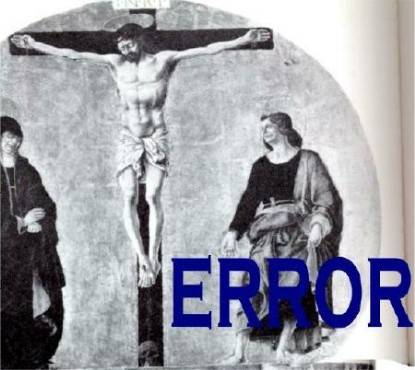
Terror is error spelled with a cross. Gnostics warned of a tendency to mental deviance in our species, which they called plané, "error, going astray." In salvationist belief, they detected the evidence and agency of this deviance. The seers of the Mysteries were accomplished theologians who opposed the Judeo-Christian idol of the divine redeemer because it glorifies suffering and undermines our rapturous bond with the earth, Sophia embodied. Salvationist faith is the mainstay of global terrorism.
Fabulating Jesus explains that Gnostic Coptic texts do not name the historical Jesus, although scholars insist on that identification.
The Tyranny of Faith, heretical reflections on the death of the Pope John Paul XXIII and the problem of faith.
Armegeddon Politics describes the recent origin of the Rapture scenario widely embraced by Christians in the US and elsewhere.
Jesus Mystified:
A Review of The Jesus Mysteries and Jesus and the Lost Goddess by Timothy Freke and Peter Gandy
Betrayed by God is a critical reviews of speculation triggered by the Gospel of Judas, demonstrating my notion of "goofy gnosticism."
The Resurrection Scam, more of the relations of Judas and Jesus as an example of victim-perpetrator collusion treated at length in my book, Not in His Image.
The Jesus Scandal discusses Hollywood director James Cameron's documentary on Jesus, intended to disprove miraculous resurrection, related to the Da Vinci Code notion of a sacred bloodline.
The Last Taboo discusses the sexuality of Jesus/Christ with reference to Wilhelm Reich (The Murder of Christ) and a famous monograph by art historian Leo Steinberg showing the savior with an erection, and other scandalous images from medieval art.
Mesotes - The Gnostic Christos tackles the question of the identity of the mystical Jesus or Etheric Christ as distinguished from the historical messiah, the darling of conventional Christian faith. One of the most important definitive essays on site.
/Telestics
is a term of my invention, derived from the Greek telos, "aim, end, purpose." I have often pointed out that the title "Gnostic" was an insult, never used by the people to which it was directed. The seers and teachers of the Pagan Mysteries called themselves telestai, "those who are aimed." Telestics is the art of interpreting the mystical and supernatural elements of human experience in a sober and rational manner, yet without dismissing or denying the authenticity of such experience. Gnosis was an ancient form of noetics, the science of relating mind to phenomena, natural and supernatural. In telestics, the insights of noetic science can be brought to focus specifically on issues of human purpose, cosmic order, and so forth.
It specifically treats the diagnosis of social evil and presents Socratic techniques for confronting it.
Insane and Inhumane is a foundation essay on the premises of metahistory, the archetype of the shaman, and the human role in Gaia's purposes. It raises the crucial question: If the beliefs you hold are insane and inhumane, how would you know?
Children of the Damned is another foundation essay that tackles the daunting problem of how to define humanity and the human race. It refers to the sci-fi/horror film (essay title) to examine the question of "human potential."
When the Mysteries Died on ecstasy and intolerance in the Pagan world, explains how religious fanaticism destroyed the millennial tradition of the Mysteries in which Gnostics (who called themselves telestai) were the directors and teachers.
Approaching Gnosticism presents three definitions of Gnosticism, with reference to salvationism and the "plasmate" of Philip K.Dick.
Honeycomb Light of the Christos offers my personal account of the mystical experience sometimes called "meeting the Etheric Christ." I believe that my description of the fractal hexagonal structure of the Organic Light in which the luminous phantom appears is unique, although the experience of this meeting certainly is not.
A Sheaf of Cut Wheat is a refutation of the hologram or holographic theory of consciousness (proposed by Karl Pribram and others), drawing upon the evidence of the Eleusinian Mysteries.
The Gnostic Gallery 1, a visual tour of the Mysteries coming forward in time from the Upper Paleolithic era, circa 12,000 BCE
The Gnostic Gallery 2, continuation of the tour into historical times.
Greek Buddhas illustrated essay on the merge of Indian and Greek art in Gandhara in the Hindu Kush, around 300 BCE. Presents evidence for the cross-fertilization of Buddhism and Gnosticism.
Through A Gnostic Lens lists 31 controversial points relating to the problem of alien intrusion, global manipulation, behavioral control, etc., many of which may be elucidated through reference to Gnostic teachings.
Origins of the Gnostic Movement, an important orientation essay, explains the split of the Magian Order, the tricky problem of Persian duality (Zoroastrianism), and makes the crucial distinction between Gnostics and Illuminati.
The Madness of the Ego reveals an extraordinary Gnostic-Buddhist parallel: the demented alien god Jehovah equated to a Buddhist demon or delusional entity, using textual citations. Striking evidence for the close correlation and perhaps historical cross-fertilization of Buddhism and Gnosis.
Karma is a Rigged Game : Archontic Influence in Human Psychology and Social Order considers, and dismisses, the widely held notion of karmic compensation. Using a unique passage in a Gnostic text, this essay considers how Sophia may use archons to test humanity through hiermarmene, "the binding of fate."
On the Illuminati excerpt from Not in His Image with further clarification on the distinction between Gnostics and Illuminati.
Gnosis Today: Reich, Noetics, and Metahistory
Suppressed Wikipedia Article is a position piece I posted on Wikipedia warning about the disinformation around the subject of Gnosticism.
§ On the Debate Over Human-made Global Warming:
Planetary Vision, Perverted considers how a Gaian, green, or planet-friendly perspective can be perverted into a false appeal to "save the planet,"
currently invoked in support of globalization and other schemes for mass behavior control.
§ On 911 and Arrogation:
Essays on social evil and Socratic techniques for confronting it.
Introduction to deconstruction of social reality, and practice with visionary intent (Sophia's correction).
Arrogation, the practice of talking back to authority, sets out what I call "deconning probes," basic tools for telestics.
The 9/11 Solution proposes an explanation of HOW the attacks of September 11, 2001 were accomplished, consistent with the "no planes' theory. This essay suggests that 9/11 be viewed as an alarm signal, a unique call to planetary conscience.
Surro-Predation and Global Psychosis (in development) defines intra-species predation and its central role in the current global breakdown of human society.
/The Gnostic Castaneda
The Sham and the Slither continues from the introduction page with some suggestions for assessing authenticity in shamanic experience.
Dreaming Castaneda: A First Person Encounter In case you were wondering.
Gnostic Parallels in Castaneda, one of the most hotly discussed essays on site, covers the extraordinary correlations that can be identified between the language of Castanedan sorcery and Gnostic concepts from the Mystery Schools.
Carlos Casanova I: Sex and the Sorcerer
Carlos Casanona II: The Sorcerer's Bluff
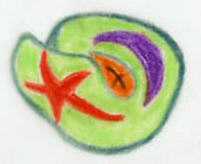
GAIA-SOPHIA
Here is the core of metahistory.org, presenting the "future myth" proposed in the mission statement. I do not say "new myth," because there is no such thing as a new myth, although myths appear at different stages of expression in various cultures, in various ages. Metahistory.org is not an activist site proposing tactics or practical measures to improve society or save the planet.
Rather, it offers a challenge for imagination.
There are critical limits and clear criteria for this imaginative adventure of dreaming with Sophia.
DISCLAIMER: The Gaian orientation of this site does not imply that the earth needs to be saved from the human species by an elite program of social engineering, eugenics, and depopulation. It does not endorse the argument that pollution of our habitat and depletion of natural resources necessitate such measures. Site author John Lash does not approve the theory of human-made global warming. On no account can writings on metahistory.org be cited to support a falsely alleged "pagan" call to "earth worship" that disguises an agenda of genocide, transhumanism, and off-planet salvation.
In the Gnostic perspective of this site, Sophia, the embodied wisdom of the earth, is the savior of humanity, not vice versa. The earth will take care of herself no matter where divine paternalism and the global psychosis lead the human species.
For more elucidation on this crucial issue, see Planetary Vision, Perverted and Prelude to the Ronda Moment.
In this section, metahistory.org invites participation in a directive script, a story to guide the species that might aim humanity toward a sustainable society in a planet-friendly future. The sacred narrative here proposed is not my invention: it is the restoration of the myth of the fallen goddess drawn from Gnostic and Pagan sources. This is a genuine planetary myth, one of its kind, as far as I know. GAIA-SOPHIA presents material in three categories, starting with general orientation:
THE TRUE ANARCHY OF LIFE ON EARTH with audio commentary. The first essay in the series of post-correction writings (after March 2011), this is the general introduction and orientation to the treatment of Sophia's correction on metahistory.org. It describes how we are currently living a mythogenetic moment of unique opportunity, as prefigured in a preterrestrial event described in Gnostic myth: Sophia confronts the Archons and foretells their defeat by humanity at the moment of the consummation of their works, right now.
Essays in the post-correction series are signalled IN CAPITALS. These writings are filed under GAIA-SOPHIA/mythos.
READING THE CAPTAIN'S LOG
1 The Mythogenetic Moment Demonstrated
2 Navigation by the Stars
3 Gaian Dreamtime : Recapitulations of the Wisdom Goddess
4 Trance Mutation: Epigenesis and Subliminal Recall
5 Two-Course Correction and Deep Immersion
6 The October Correction: Tugboat Jupiter
7 Reflections and Corroborations
8 Planetary Vision Quest
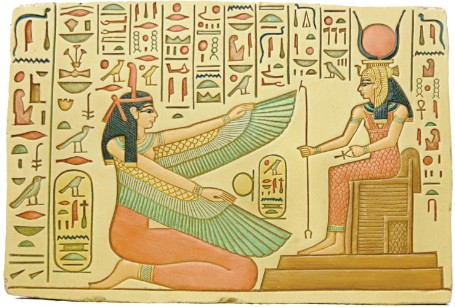
A Planetary Myth from the Pagan Mysteries ("Or Ever the Earth Was") shows that the figure of Wisdom, represented at the handmaiden of the Old Testament father god, is the gnostic Sophia, a divinity who embodies in the earth—rather than the mere servant of a male deity who claims to be creator of the earth. Quitessential reading.
The Fall of the Wisdom Goddess is a summary of the Sophianic myth of the Mysteries in nine episodes.
The Fallen Goddess Scenario - Summary and Evaluation presents yet another version of the nine episodes with special attention to the astronomical features of the myth. Also considers if the Sophia myth is a merely a metaphor, and offers an inventory of the many unique points contained in the FGS.
Wooing the Wisdom Goddess (1): Considerations of Reconstruction of the Sophia Myth covers my consideration in recovering and restoring the vision story of the Mysteries, the myth that guides the human species.
Wooing the Wisdom Goddess (2):
Textual Sources of the Fallen Goddess Scenario.
The Imagined God is a brief essay on the "theopathic question" and the choice between Gaia (feminine) and God (masculine).
The three-part essay, Promise of a Lonely Planet, under archon files, also covers essential aspects of the Sophianic vision story. Not to be missed.
/mythos
Overview of the Gaia Mythos is an explanation of how I handle the myth, and why I frame it with allusions to modern astronomy, shamanism, and so forth. Essential to know how I have proceeded in restoring the sacred narrative that survives in pitifully skant and fragmented materials.
Sharing the Gaia Mythos sets out the nature of the Gaia Mythos as a participation narrative or vision story to be developed in a tribal or community setting.
Sources of the Gaia Mythos describes how I have recovered and restored the myth, with various references to modern biology and science, although such references are not necessary to validate or legitimate the sacred narrative.
Gaia Mythos 1 - 8 Episodes pisodes of a projected prose poem version of the Sophia story.
SPOKEN VERSION episodes 1 - 8 : JLL added December 2014
Gaia Mythos 8 - 16 Three more episodes. The prose poem version of the myth is incomplete.
Commentaries on the Gaia Mythos is a set of notes linked to the episodes.
/sacred ecology:
i.e., essays on "the sacred theory of the earth," developed from
Pagan, Indigenous, and Gnostic sources.
Coco de mer I: The Human Role in Gaia's Dreaming, an essential essay on Gnostic cosmology, co-evolution in Gaian terms, and the open source spirituality that fits the Sophianic vision of the earth.
Coco de mer II: The Shock of the Beautiful sets out the role of erotic play, beauty, and pleasure in a Gaian perpective.
Gaia and Gnosis I: The Unspelling of the Earth is a dense essay on the sacralization of the earth, citing an important precedent to Grail myth in Celtic legend. A key position paper on biomysticism or Gnostically informed animism.
Gaia's Age: An Eccentric Calculation in which I show that Gaia, our planet considered as the goddesss Sophia embodied, is not an old crone in her last years but a budding young nympho of 23.
"The standard
geological
timeframe
makes
Gaia
appear
to be immensely old, as she truly is in human terms, but in her own
time she is still quite young. A mere lass of 23 and some months. This
startlingly low figure introduces a totally new way to think
about the evolution of the Earth."
See also under 2012 Shift (Endtime) Sophia Unveiled: The Resurgence of the Mysteries in the Endtime
Click here to continue the SPOKEN TOUR (part 4).
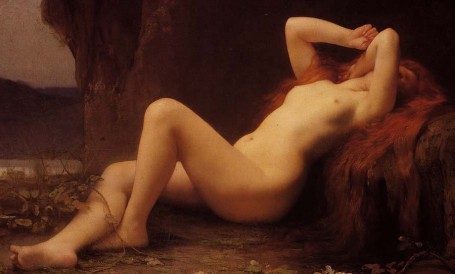
"Magdalene in the Cave." J. J. Lefebvre, 1826.
Centerfold girl for the mystical wet dream of Romanticism.
The harlot is redheaded according to a long-standing rumor.
MAGDALENE
Metahistory.org went on line in July 2001 when world-wide controversy over Dan Brown's novel The Da Vinci Code was escalating. Interest crashed not long after the debut of the appalling film based on the novel, early in 2006. During that five-year period, anyone writing on Gnosticism or the Tar Baby Jesus was under heavy presssure to pronounce some view or other on the figure of Mary Magdalene. I weighed in by dedicating an entire section of the site to her. Why She Matters So (MM Navigator) is the orientation page to the Magdalene material on site, which comprises an entire book in its own right.
When MM went mainstream, I had been stalking the Harlot of Heresy for a good thirty years, well over half my life. Initially, I tended to view her as a counterpart and balance to the male redeemer figure Christ. Together they might have provided the model for gender-balanced version of "Erotic Christianity," as I dubbed it around 1987. But with deepening study of the Gnostic materials, I came to view her as wholly Pagan and not in the least Christian, i.e., a trophy wife for the Messiah. This latter view is reflected in the essays compiled in this folder, which comprise a complete book.
Celebrating MM sets the tone and mood for my approach to this heretical heroise, an immensely rich and significant figure in Western culture, both sacred and profane. The initial ambitions of this section, intended to showcase many views of MM in art and literature, were not completed.
She Who Anoints is a book review of Mary of Magdala by Karen King. It is highly critical of King's view, shared by most Gnostic scholars of Christian faith, that Gnosticism was merely an early, immature phase of Christianity, a mere splinter in the vast movement that came to conquer the world.
The Gnostic Avenger is a radical portrait of Mary Magdalene as a Pagan initiate and adept of the Mysteries.
The Magdalene Connection
is an ambitious three-part essay, a monograph presenting the highlights of a radical view of Magdalene as she stands apart from Christian spin and cooptation.
1 The Myth of Choice tackles the sexuality of Christ and different views of MM as saint and prostitute.
II The Backstory describes the noble example of love and soul-bonding in Pagan spirituality, suggesting what Jesus and MM would have been like had they been Pagans rather than Christians.
III The Love Story examines the role of MM as a teacher of love who reconciles sex and spirituality. Doing so, it touches on the powerful archetype of the Lovers exemplified in the medieval legend of Tristan and Isolde.
NOTE: This monograph, especially the third part, closely complements the essays on sacred sexuality in The Alternative History of the Grail, especially Faith Incarnate with its emphasis on the love-death of Tristan and Isolde.
Unmaking History: The Sion Scenario, a review of The Da Vinci Code, presents my objections to linking a theocratic bloodline with the figure of Mary Magdalene. I argue that taking her womb for the "Grail," i.e., the matrix of a sacred bloodline, is wrong on scholarly terms, on mythological terms, and, worst of all, on ecofeminist terms.
For critical reflections on The Da Vinci Code scam, the Priory of Sion, and (in my view) serious misrepresentations of Pagan Gnosticism relating to MM, see also The Most Enigmatic of All Enigmas in The Alternative History of the Grail.
LIVING MYTH
is the most recent category added to metahistory.org (September 2009), the last of thirteen buttons exclusive of Planetary Tantra which is a site within the site, an open terrain in its own right. In this section, I follow the four precriptions of Joseph Campbell suggestive of "creative mythology," but extrapolated in an idiosyncratic way. Hence I suggest the terms applied mythology or dynamic mythology. A myth is actional if it is actually applied to experience as a factor of intention, vision, and enactment, not merely for the interpretation of experience.
This section presents myths in progress, including poetic juvenalia of the Maine terton (Translations from the Andromedan) with extensive notes on the prehistory of humanity, and some commentaries and critical writings on the problems of applied or dynamic mythology.
Introduction: I discuss Campbell's mistake in advising the plot for Star Wars,
and other knotty problems relating to the art of applied imagination. NOTE:
This essay is incomplete and has a long way to go.... I might resume it verbally when I get around to putting mp3 files on site in 2010. Some fair day.
I feel compelled to apologize for broadcasting the embarrassing lyric splurge of the Translations, but this callow indulgence does not carry the expectation that anyone will read it. As proof that I am not entirely lacking in self-censoring abilities, I have not included pictures of my cats.
MYTHS IN PROGRESS
"Take Back the Earth", a review of James Cameron's Avatar
To my knowledge, the rewritten myth of Orpheus and Eurydice is the first of its kind, a classical myth given a different ending. Campbell and Eliade were theorists who did not attempt to revise myths and might have considered such revision an arrogant presumption. This revised myth has three parts: othe first is posted here, with the other two parts still in draft form. In all, the three parts might comprise a small book or basis for a libretto, an operatic version. In my wildest dream, I hear the voice of Eurydice sung by Greek diva Savina Giannatou.
When my Eurydice returned, she did so, not with her own voice, but with a borrowed one. Such is the difference between myth and reality. Or perhaps better said, the distance. Myth is mere vapor without human reality to reflect it, but distance and distortion operate in that reflection as they do in all human interactions. Who among you can live in the depth of what you truly feel?
Farewell, Eurydice.
jll December 2009 Andalucia |
Orpheus and Eurydice - A Myth Rewritten
Part One: The Return of Eurydice
Part Two: The Beauty of Goodbye
Part Three: The Flight of the Black Swan
* * * * * * * *
Translations from the Andromedan
An Alternative Myth of Human Origins and Gender Conflict
Preface by the Translator
C O N T E N T S
Sweet Talk in the Syrene Limb
Walking the Alameda
FlintstruckLight
Prodigal Heart
The Physics of Beauty
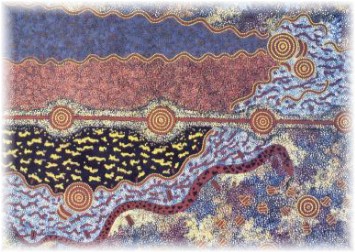
Five Dreamings (detail), Michael Nelson Jakamarra
Dreamings: The Art of Aboriginal Australia
Asia Society Galleries, New York, 1988
Living Myth: Commentaries and Critiques
Tree-Nymphs and Tree-Hung Shamans presents a glimpse into the remote time when arboreal nymphs (tree-women), the sole human inhabitants of the earth, were confronted by hunters from Orion, their male counterparts.
I The Myth of Adonis further elaborates on the arboreal mythology of the Gaian paradise.
II The Chthonian Romance considers the little-understood mythological theme of "the separation of the sexes," with reference to the Divine Sophia and the Anthropos (human genome).
III The Consciousness of Nature is an extended explanation of the remote origins of shamanism and the complex process of cognitive binding of the human species into the lifeweb of the planet. This essay demonstrates how to read myth as a record of phylogenetic memory.
************
SPOKEN TOUR (part 5) - forthcoming.
SKY LORE
This section of the site presents a loose and incomplete collection of writings on the knotty problem of the two zodiacs, star-based and starless, plus articles relating to astrology, sidereal mythology, precession, and so forth.
Having been occupied for some thirty-five years of my life with sky-watching and astronomical studies, I feel compelled to pass on what I have learned. Lacking students to teach in flesh-and-blood, or anywhere to teach, I have resorted to dumping my sky lore on this site. In the profession of astrology, I struggled against the grain, never accepting that planets cause human behavior, refusing to predict or play guru to my clients, and battling right, left, and center with (to me) unacceptable concepts and techniques that litter that ancient and much corrupted genre.
Quest for the Zodiac is a total makeover of astrology incorporating the stellar dimension or StarBase©. I would like to publish it entirely on site but without assistance with editing, formatting, and graphics, that will not be possible.
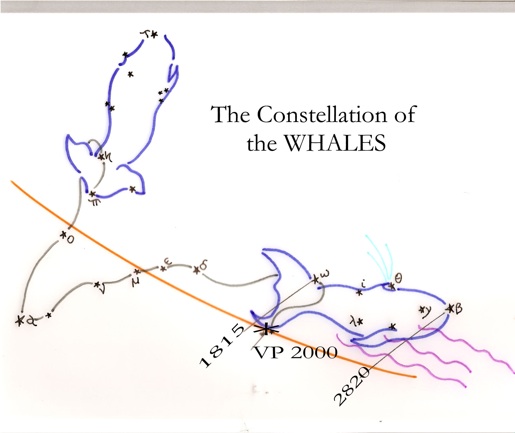
Constellation of the Fishes (astronomical Pisces) with historical timing of precession of the spring equinox (VP) indicated by specific stars. Note the end of the Piscean Age when the VP aligns to the star beta in the nose of the Western Fish: 2820 CE, eight centuries from now. © John Lash 1983
M O O N D A N C E
Lunar Calendar and Dakini Instruction: Technically,
this material belongs to Planetary Tantra but I signal
it here because there is so much sky lore to be found
in these particular writings. For orientation, go to
Cruising the Lunar Shaktis

Shaman in the Sky: The Evolutionary Message of the Solar Apex. Considers the significance of the constellation of Hercules, location of the Solar Apex, in relation to the role of sacred plants in human evolution.
Hercules and Serpentarius shows graphically the connection between these two massive figures, shamanic heroes of ancient legend.
A Primer of Stellar Astrology
consists of several chapters from Quest for the Zodiac, revised
and formatted for the website. These lessons are incomplete.
Ch. 1: In the Dark of Night - orientation to basic astronomy relating to real-sky observation of the constellations, distinguished from the 12 astrological signs
Ch. 2: Astrology Without Stars - further explanation of how astrology ignores the stars
Ch.3: Visions on the Rimsite - describes step by step how I developed the Rimsite model of the thirteen ecliptic constellations
Ch. 4 Cycles of Animations - complete tour of the graphic or visualized form of the constellations
"Dendera Decoded"
Unpublished MS interpreting the entire sequence of the World Ages in Dendera Zodiac, revealing my discovery of a fifth axis pointing to the galactic center. To be published sequentially in 2010 as time and circumstances allow.
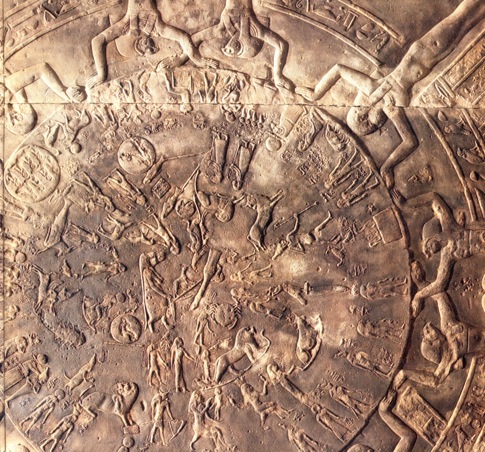
2012 SHIFT (Endtime Essays)
Closely related to my study of the Dendera Zodiac, these essays cover the mythical and astronomical background of the 2012 debate and present some suggestions on what that date might entail as a window of opportunity
looking toward a "planetary shift."
With eight chapters and an afterword, this is an entire book, complete.
1 Countdown to 2012: Reflections on Kala Yuga, the Mayan Endtime, and the Narrative Spell of Western History
2 The Discovery of the Next World: The Five Tribes of Kali Ma
3The Party of Xolotl: Magic and Initiation Among the Endtime Tribes
4 Stars on the Endtime Horizon: Real Sky Observations for 2012
5 Aquarian Waves: Parameters of the End of the Piscean Age
6 Sophia Unveiled: The Resurgence of the Mysteries in the Endtime
7 The Tablet of Destiny: Omens in the Skywriting for 2012
8 Beneath the Gaze of the Goatfish: Transpeciation, Telepathy, Terma
9 The Cypher of Ollin: Genetics and Illumination in the Endtime
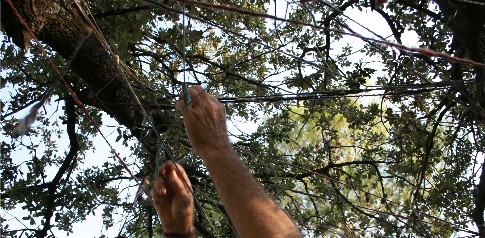
RITE ACTION
Introduced in May 2008, this 13th and final category of metahistory.org contains so far just a single essay on Contra-Violence and Warrior Ethics. In that essay, I question the notion of karma as a reward and punishment system, and I argue that accountability can only be voluntary, never imposed or enforced. I define contra-violence, as distinguished from the non-violent resistence of Gandhi and others, and suggest an approach to rite action through owning the force of transpersonal rage.
In May 2008 I launched the gambit of a dangerous animal with a couple of essays on "the topic of topics," predation. These writings present an initial foray into an area of extremely volatile issues but ultimately they concern the self-defence of the human species against predation from its own kind.
Open Season on Predators I: Contra-Violence in the Cause of Peace
Open Season on Predators II: The Threat of Intra-Species Predation
Due to conditions and limitations at that critical moment, May 2008, I was unable to proceed with either the theoretical framework or the practical exposition required for this theme. At the moment of completing this revamped site guide, December 2009, I have no idea how or when I will resume writing on the practice of contra-violence through rite action, i.e., ritualized expression of transpersonal rage directed at specific targets, including individual persons, with intent harm, neutralize, and eliminate.
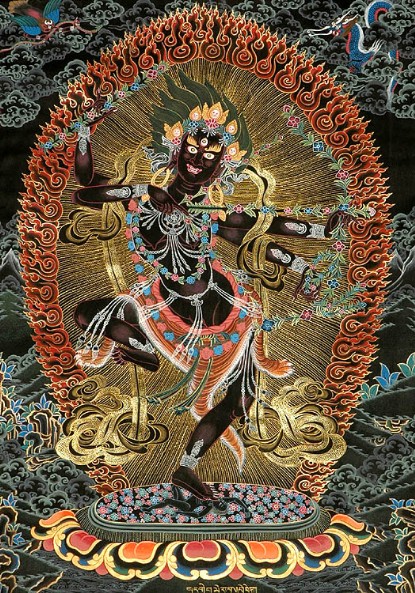
Kurukulla, Diamond Sky Dakini of the Shakti Cluster
Mistress of Witchcraft and Sexual Enchantment
"Love didn't get the species into this mess, and it won't get us out."
JLL to Lydia, September 2009
"Truth on human terms has a half-life of five seconds."
Lydia to JLL, December 2009
festina lente: make haste slowly
|
|



